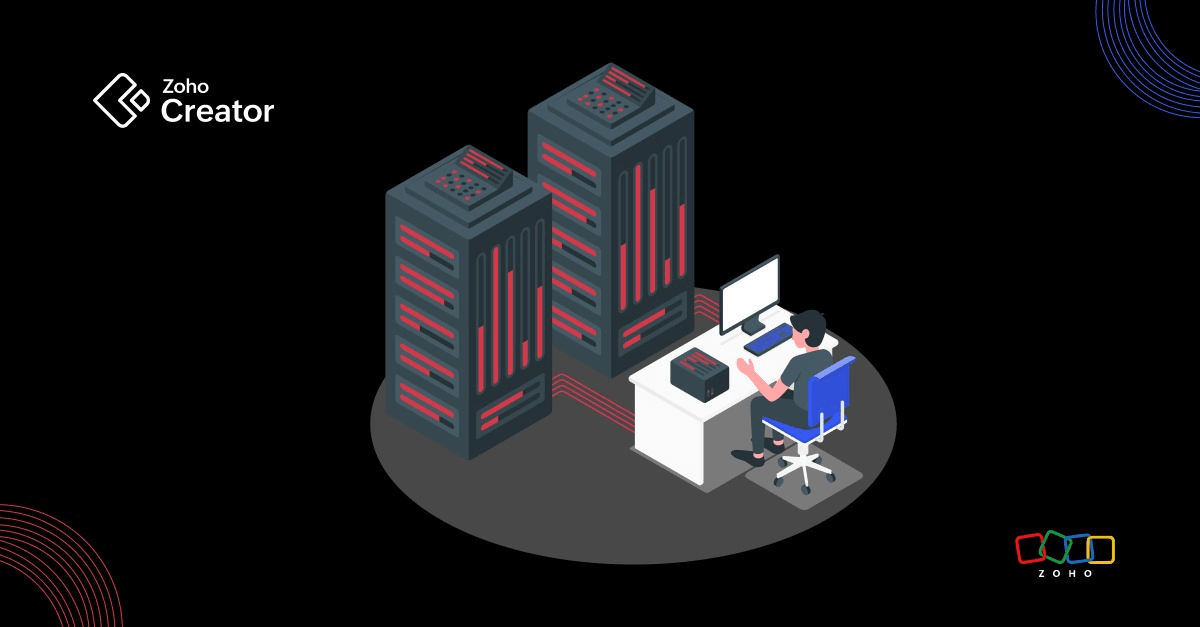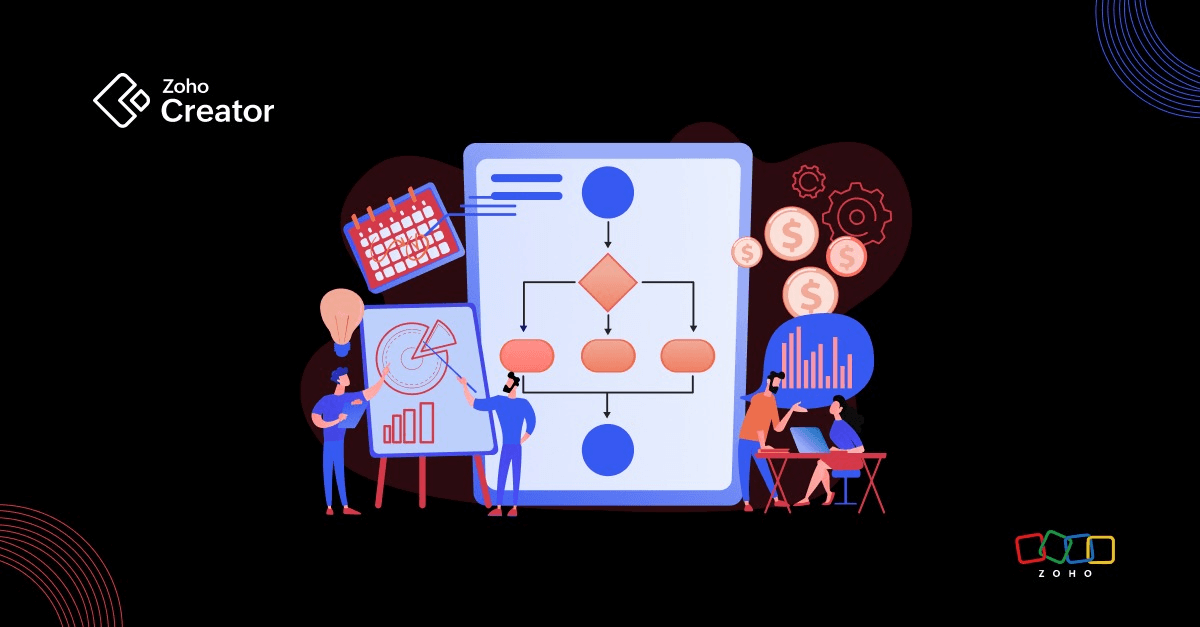- HOME
- Know Your Tech
- AI and low-code platforms: Revolutionizing app development
AI and low-code platforms: Revolutionizing app development
- Last Updated : July 23, 2025
- 336 Views
- 12 Min Read
TL;DR: AI-powered low-code platforms are transforming app development by enabling faster, smarter, and more accessible application creation. These platforms blend intuitive visual builders with AI tools like predictive analytics, NLP, and automation to simplify workflows, reduce IT dependence, and cut costs. With these platforms, non-developers can now build intelligent apps without deep coding or AI expertise. While challenges like data quality, security, and integration still exist, the future of low-code AI promises domain-specific intelligence, ethical AI, and autonomous app generation—reshaping how businesses innovate and operate at scale.
Imagine having the ability to create the tools your team needs, whether it's a leave tracker, an approval workflow, or a streamlined way to collect customer feedback, without relying on overloaded IT teams or developers. In 2025, AI-powered low-code platforms are changing the way applications are built. These platforms enable non-developers to design and deploy apps using intuitive visual interfaces, while AI assists in automating logic, suggesting features, and speeding up development.
By 2026, Gartner predicts that people outside traditional developer roles will create 80% of applications. This shift is enabling business teams to solve problems independently and innovate without waiting for IT priorities to align.
In this blog, we'll explore how AI-assisted low-code platforms are reshaping application development. You'll learn how teams are accelerating their projects, automating repetitive tasks, and building the custom tools they need, all without needing deep coding expertise.
What is AI-assisted low-code application development?
AI-powered low-code application development platforms combine the ease of low-code development with the power of AI. These platforms enable rapid application creation with minimal coding while incorporating AI technologies to automate tasks and improve performance. Integrating AI into the development process improves workflows, reduces manual effort, and accelerates time to market, making it easier for developers to build custom applications.
Unlike traditional low-code tools, low-code AI platforms embed advanced technologies like machine learning (ML), natural language processing (NLP), and predictive analytics directly into the development cycle. This allows businesses to create intelligent applications without requiring deep AI or machine learning expertise.
Traditional low-code vs. AI-powered low-code
To understand the difference, let's examine how AI integration shapes the development process compared to traditional low-code platforms.
Feature | Traditional low-code | AI-powered low-code |
Ease of use | Visual tools and templates | Automates tasks like logic and UI generation with AI |
AI integration | No AI features | Fully integrated AI for code generation, improvement, and workflow optimization |
Generative AI | Not applicable | Uses NLP and other generative methods to create code and design components automatically. |
Development speed | Faster than traditional coding, but still manual for tasks like writing initial code, debugging, and integrating components | Speeds up development by automating app creation tasks |
IT dependency | Requires IT for complex tasks | Reduces IT dependency further with AI handling tasks |
AI-powered low-code platforms offer a more automated, intelligent development experience, allowing for faster iterations and greater efficiency in building complex applications. Next, we'll look at key benefits.
Key benefits of AI-driven low-code development
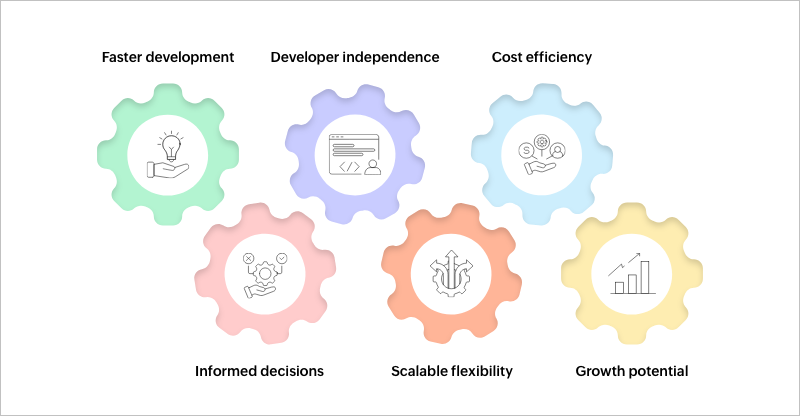
AI-driven low-code platforms make app development faster, more efficient, and more accessible. Let's take a look at how they simplify processes, reduce reliance on developers, cut costs, improve decision-making, and scale solutions to meet growing business needs.
Accelerated app development
AI integration with low-code platforms like Zoho Creator significantly speeds up the app development process. Traditional development requires extensive coding, debugging, and testing, taking months to complete. However, AI-powered low-code platforms simplify this process using visual tools and preconfigured AI modules.
AI automation: AI can handle repetitive tasks like data validation and decision-making, reducing manual effort and speeding up development.
Rapid prototyping: Prebuilt AI components, such as predictive analytics or sentiment analysis, allow for quick testing and iteration, shortening feedback cycles.
Agile deployment: With AI pre-integrated, real-time updates and adjustments can be made, allowing businesses to scale and change functionality without redeveloping the entire application.
For example, a business could quickly build a customer feedback system that uses AI to analyze reviews automatically. Instead of waiting for manual analysis, the system would process data instantly, and any necessary updates or improvements could be rolled out swiftly, all without extensive development efforts.
Reduced dependency on developers
AI-powered low-code platforms allow non-technical teams to take part in app development. This reduces the burden on IT departments and speeds up the delivery of solutions. These platforms offer a variety of user-friendly AI tools that simplify complex AI tasks.
Prebuilt AI logic blocks: Many low-code platforms, like Zoho Creator, provide prebuilt AI tools like sentiment analysis, prediction models, and keyword extraction, enabling business users to implement machine learning models without coding. For example, sentiment analysis can automatically analyze customer feedback, prediction models can forecast trends like sales or customer churn, and keyword extraction can help identify key themes or important phrases in large datasets.
Drag-and-drop interfaces: These intuitive interfaces allow business users to integrate prebuilt machine learning models, like classification models for categorizing data or regression models for predicting numerical values, into applications without needing coding skills. By simplifying the process, these interfaces enable faster development and reduce reliance on technical teams. For example, users can integrate regression models to predict sales trends or classification models to categorize customer feedback. These AI models can also be easily integrated with workflow automation tools, enabling businesses to automate tasks like data validation, approvals, and notifications.
Automated workflows: AI-powered automation tools let users create logic flows that trigger actions based on incoming data. For example, automated email responses or data validation tasks can be built in to the platform's interface.
These tools enable non-technical employees, such as business analysts or operations managers, to build intelligent solutions, cutting down on time-consuming development processes and reducing IT involvement.
Cost efficiency
AI-powered low-code platforms can save businesses significant costs in both development and operations by reducing the need for expensive, resource-heavy development processes and specialized AI talent.
Lower development and maintenance costs: Preconfigured components and AI tools reduce the need for large development teams, cutting labor costs and shortening time to market.
Scalable infrastructure: Many low-code platforms are cloud-based, eliminating the need for businesses to manage costly hardware or infrastructure. These platforms automatically scale as usage increases.
Operational efficiency: AI-driven automation reduces manual tasks, allowing businesses to reallocate resources to more valuable activities, further driving down costs.
With these savings, businesses can innovate faster and operate more efficiently without the need for specialized, large teams.
Better decision-making
AI-enhanced low-code platforms provide businesses with real-time data insights, improving decision-making processes. By automating data processing and offering predictive analytics, these platforms enable smarter and quicker decisions.
Predictive analytics: AI models can analyze historical data to predict future trends, such as customer behavior or inventory needs, helping businesses make informed decisions.
Automated decision support: AI-driven workflows can prioritize tasks, manage exceptions, and offer alerts based on real-time data, improving operations.
Improve customization: Businesses can fine-tune AI models to address specific challenges, whether improving logistics or personalizing customer interactions.
These capabilities allow businesses to make more accurate, timely decisions that lead to better outcomes.
Flexibility and scalability
AI-powered low-code platforms often offer flexibility, enabling businesses to scale applications as their needs evolve or data volumes increase. These platforms are built to support growth by allowing easy adjustments and expansions without requiring a complete overhaul of existing infrastructure, ensuring that businesses can adapt quickly to changing demands.
Modular architecture: These platforms let businesses add or remove components based on changing needs, ensuring that applications remain adaptable.
Automatic AI optimization: Built-in machine learning models allow applications to adapt to changing data with minimal manual intervention.
Seamless integration: Low-code platforms integrate easily with existing systems like CRMs and ERPs, ensuring smooth data flow across the organization.
This scalability ensures businesses can keep pace with growth without needing to rebuild or completely overhaul their systems.
Market growth and future potential
The demand for AI-powered low-code platforms is on the rise. With the low-code market potentially reaching $50 billion by 2028, businesses are increasingly looking for ways to integrate AI and improve development processes.
Making AI accessible: AI-powered low-code platforms make AI more accessible to smaller organizations, without the need to hire specialized AI talent.
Rapid innovation: These platforms enable businesses to quickly build and deploy applications, staying agile and able to adapt to changing market conditions.
The shift towards AI-powered low-code platforms reflects a growing emphasis on speed, cost-effectiveness, and innovation.
Though AI-driven low-code platforms simplify many development processes, businesses must still handle some challenges to ensure successful implementation.
Challenges in integrating AI into low-code development
According to a July 2024 Gartner survey, 63% of organizations either do not have or are unsure if they have the right data management practices for AI. And the cost of this gap is steep.
While low-code platforms aim to simplify development, adding AI into the mix introduces a complex layer of technical, ethical, and operational challenges. Below are the key risks that must be addressed for successful AI integration in low-code environments:
Data quality and bias
The challenge: AI systems are only as good as the data they’re trained on. Low-quality, incomplete, or biased data can lead to inaccurate predictions and flawed outputs.
Why it matters: Misaligned datasets not only reduce model performance but can also reinforce harmful biases in business logic and customer experience.
Security note: AI often requires access to large volumes of sensitive data, making robust privacy and governance frameworks essential.
Security and compliance risks
The challenge: AI-generated code and automated decision-making can introduce vulnerabilities that traditional QA processes might miss.
Why it matters: Without rigorous compliance monitoring, organizations risk violating data protection laws, failing audits, or experiencing security breaches.
Skill gaps and limited expertise
The challenge: While low-code platforms are built for accessibility, AI still demands specialized understanding for proper integration, tuning, and ongoing optimization.
Why it matters: A lack of in-house AI knowledge can derail implementation, reduce model accuracy over time, and increase reliance on external consultants.
Integration with legacy systems
The challenge: Many enterprise systems are outdated and were not built to interface with modern AI tools or cloud-based low-code platforms.
Why it matters: Integrating AI with legacy infrastructure requires custom connectors or middleware, adding time, complexity, and cost.
Customization and flexibility limitations
The challenge: AI features within low-code platforms are often generalized and may not offer the depth needed for niche use cases or advanced business logic.
Why it matters: Developers may feel constrained, and businesses may struggle to adapt AI models to fast-changing needs or unique workflows.
Transparency and trust
The challenge: Many AI systems operate as "black boxes," offering limited visibility into how decisions are made.
Why it matters: Lack of explainability undermines user trust and complicates regulatory compliance, especially in sectors like finance, healthcare, or public services.
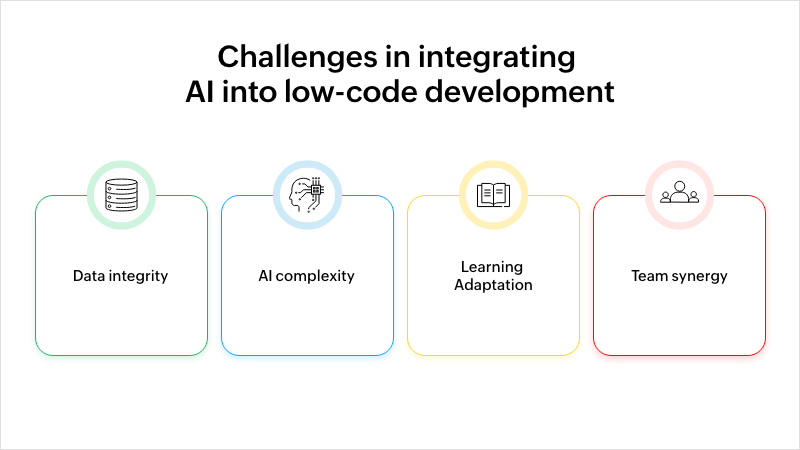
While many AI features are now standard in low-code platforms, these ongoing challenges show that there is still work to be done for organizations that want to get the most out of AI in their development efforts.
Real-world use cases of AI-powered low-code platforms
Many teams face everyday challenges, like manual approvals, slow data entry, or unclear sales priorities. However, without enough developer support, solving these problems quickly becomes difficult. AI-powered low-code platforms help non-technical users build innovative tools using visual builders and built-in AI features.
Automating customer support with AI chatbots
Support teams often spend hours responding to the same set of questions. Using low-code platforms with AI, teams can create chatbots that understand basic queries and respond in real time.
AI tools used: Natural language processing, sentiment detection
What it helps with: Reduces the number of support tickets handled manually
Example: A chatbot answers questions like “How can I reset my password?” or “Where is my order?” using pretrained AI models, all built through a visual interface
Smarter lead scoring for sales teams
Sales teams can waste time chasing leads that never convert. AI in low-code platforms can help score leads based on past behavior and interactions.
AI tools used: Predictive analytics, classification models
What it helps with: Allows sales reps to focus on the leads most likely to buy
Example: A sales manager builds a lead scoring tool that ranks prospects based on email engagement, website visits, and purchase history
Faster invoice processing in finance
Manual invoice processing takes time and often leads to data entry mistakes. Low-code tools with AI can extract information from documents and route them for approval automatically.
AI tools used: Optical character recognition (OCR), form processing
What it helps with: Reduces manual effort and speeds up approval timelines
Example: A finance team builds an app that reads scanned invoices, pulls key fields like amount and due date, and sends them for review
Supporting employee onboarding
HR teams answer similar questions from every new employee. With low-code AI tools, they can create apps that walk new hires through the process step by step.
AI tools used: Virtual assistants, decision flows
What it helps with: Saves time on repetitive tasks like answering frequently asked questions
Example: An onboarding app sends documents, answers questions like "How do I access my benefits?", and notifies managers when tasks are completed
Forecasting demand in operations
Many companies struggle to plan for stock levels or service needs. AI models built into low-code dashboards can help teams make more accurate forecasts using historical data.
AI tools used: Time-series forecasting, regression analysis
What it helps with: Improves planning by predicting future trends
Example: A store manager creates a forecasting app to estimate weekly sales volume based on previous months' data
Analyzing customer feedback
Manually reading and categorizing customer reviews can take hours, but low-code platforms with built-in AI can help sort responses and highlight common themes.
AI tools used: Sentiment analysis, keyword detection
What it helps with: Makes it easier to track overall sentiment and recurring issues
Example: A marketing team builds a dashboard that flags the most mentioned problems in survey responses and groups them by topic
Whether it's processing documents, improving customer interactions, or making better decisions with data, these tools allow teams to build helpful applications with less time and effort.
The future of low-code AI in app development
AI-powered low-code platforms are changing how businesses approach app development. Low-code platforms offer an efficient solution for organizations looking to improve operations and reduce IT dependency.
By allowing users to create custom applications with minimal coding, these platforms are poised to reshape the app development process. Here's what the future holds for low-code AI.
Autonomous application development
The future of low-code AI will focus on autonomy. New platforms will generate entire applications with minimal human input. By analyzing detailed requirements or observing existing workflows, these systems will create, adapt, and improve applications based on real-time usage and feedback.
This shift will lead to faster development and continuous improvement, saving your team time and resources.
Improve human-AI collaboration
AI will become a more intuitive partner for developers. In the future, AI won't just provide technical suggestions; it will explain decisions in business terms. Developers will no longer need to guide AI explicitly; instead, AI will learn from their actions and adjust to individual preferences.
This smooth collaboration will lead to greater efficiency and personalization in app development. One such collaboration is how CoCreator, powered by Zia, Zoho's smart AI assistant, works alongside you to streamline your development process and help you achieve your goals more efficiently.
Domain-specific intelligence
Low-code AI is moving beyond generic solutions. Future platforms will offer domain-specific intelligence customized to industries like healthcare, finance, and manufacturing.
For example, AI in healthcare apps will understand medical workflows and compliance, while financial platforms will incorporate regulatory frameworks by default. This ensures that applications are not only efficient but also compliant with industry standards.
Expansion beyond web and mobile
Low-code AI won't be limited to web and mobile apps. New domains like edge computing, ambient computing, and immersive applications are on the horizon.
These advancements will enable you to build apps for distributed environments, augmented reality, and virtual reality, opening new possibilities for your business and improving customer experiences.
Ethical AI integration
As AI becomes more powerful, ethical considerations will take center stage. Future low-code platforms will ensure that AI decisions are transparent and explainable.
Governance frameworks will be built to prevent biases in design and data processing. This responsible approach will help you develop applications that are innovative, fair, and accountable.
Low-code AI is set to redefine the app development process, making it faster, more efficient, and more accessible. These innovations will enable your business to stay ahead in an increasingly digital world.
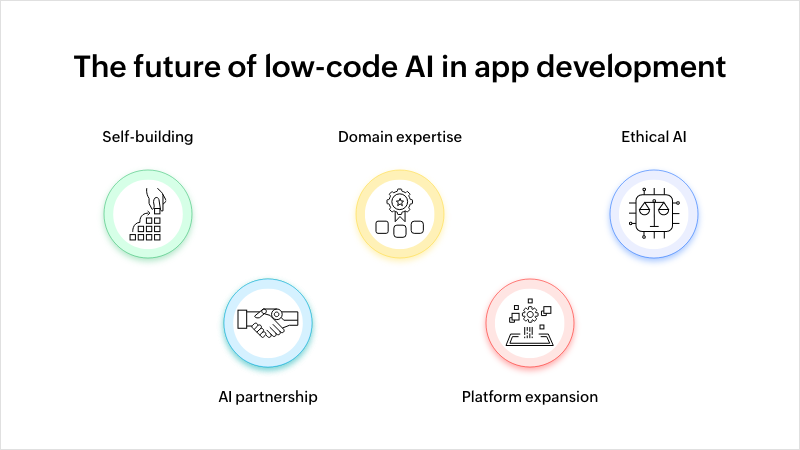
Optimizing operations with AI-powered low-code platforms
As businesses face increasing demands, automating operations and reducing IT dependency are key challenges. From small businesses dealing with slow development cycles to large enterprises struggling with high IT costs, traditional methods often impede progress. Low-code AI platforms are changing the game by offering faster, more efficient solutions that scale with your needs.
Zoho Creator is the perfect solution for businesses looking to tackle these challenges. With this low-code platform, businesses can quickly build custom applications and automate workflows without heavy IT involvement. Its AI-powered features, like autonomous application development and human-AI collaboration, help businesses stay agile and competitive.
Start optimizing your operations today with Zoho Creator. Let AI-powered low-code improve your workflows and drive your business forward. Sign up today and experience the difference!
FAQ
1. How secure is AI-powered low-code in terms of data protection?
AI-powered low-code platforms often include encryption and may offer compliance with regulations like GDPR, but the specifics can vary between platforms. It's important for businesses to carefully evaluate the security features of the platform they choose and implement their own data governance measures to ensure full protection.
2. Can AI-powered low-code platforms integrate with existing business software?
Many AI-powered low-code platforms can integrate with systems like CRM and ERP, enabling seamless data flow across business functions. However, the extent of integration may vary depending on the platform and its compatibility with other business software.
3. What support and training are available for low-code AI users?
Zoho Creator and similar platforms offer tutorials, documentation, and customer support, with some also providing training modules for users.
4. Are there limitations to using low-code AI for complex applications?
Low-code AI platforms may not handle highly complex applications as well as traditional coding, but can still complement more intricate solutions.
 Bharathi Monika Venkatesan
Bharathi Monika VenkatesanBharathi Monika Venkatesan is a content writer at Zoho Creator. Outside of work, she enjoys exploring history, reading short novels, and cherishing moments of personal introspection.

